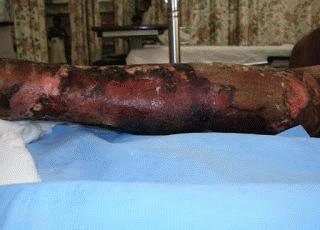A 55-year-old male, suffering from Type 2 diabetes for the last 12 years, presented with pain, swelling and dark necrotic patches over his right leg. He gave a history of minor trauma to the leg about two weeks before admission to this hospital (Aster Medcity, Kochi), for which he was being treated earlier in another hospital. He developed fever with chills, increasing infection of the right leg, and was then transferred to our institute for onward management.
He was not 'offloading' the infected lower limb, resulting in spreading of the infection, with onset of blebs and redness all over the right leg. His glycemic control was not good, and he had not been very regular with his diabetes medications, which included insulin. Physical examination of the patient revealed that the he was drowsy and febrile, with features of dehydration. He had extensive necrotizing fasciitis of the right leg. The skin and ulcers had a dusky discolouration; the lower limb was oedematous with foul-smelling purulent discharge from multiple sites of the leg. A peripheral angiogram showed extensive arterial blocks of his right lower limb, as a result of his longstanding diabetes. Due to this, and because the patient was in impending sepsis, peripheral angioplasty or a peripheral-bypass surgery was not possible. A wound-debridement surgery to remove the infected tissues was not advisable as it had a very high probability of failure due to the poor blood supply to the leg, that could lead to gangrene of the operated area, followed by multi-organ dysfunction and eventual death. The only logical surgical management was to carry out a life-saving below- or above-knee amputation, which the patient refused point blank. He said, "I would rather die, than undergo such a mutilating surgery". He was, however, ready for a debridement of the infected tissues. With the patient's written consent, we decided to apply conventional management, along with 'mind-energy technique'. And we managed to save him, as well as his leg.
'Mind- Energy' and 'Visualization'
Mind-energy techniques, in conjunction with conventional medical strategies, can dramatically improve treatment outcomes of most physical and mental illnesses. Mind is energy, and when focused correctly, and with great intensity, on the diseased organ or area, like a wound in the leg, can help cure the organ ailment and heal the wound. 'Visualization' is a powerful mechanism to focus the mind-energy to the site of the ailment and heal oneself. Care-givers can help in imparting this training to the person in need and guiding her/him till complete healing has occurred.
Saving the life and leg of the patient
In the above-mentioned case, the patient's training in intensely focusing his mind on the site of the infected wound was started even before surgery. He was told to visualize in a relaxed manner that the blocks in the arteries of his leg were slowly dissolving, the blood flow to the area was improving, collateral-circulation formation was happening, and the blood perfusion to the leg was increasing.
As per conventional management, the patient was taken up for a debridement of the necrotic area of the right leg, under anaesthesia. All the infected tissues were excised, tissue sent for bacterial culture and antibiotic sensitivity. On the operating table, the blood flow of the wound was found to be satisfactory, since the patient had already started focusing his 'mind- energy' on the right leg to improve circulation. After surgery, daily wound dressings were carried out, strict offloading of the operated leg, culture-specific intravenous antibiotics were started, tight blood-sugar control and other required supportive therapy commenced.
Along with this, the patient was also taught the basics of wound-healing physiology. He was told to concentrate his mind on the operated wound, and to visualize the physiological processes of increasing the circulation and wound healing.
(Note: You can view every article as one long page if you sign up as an Advocate Member, or higher).






